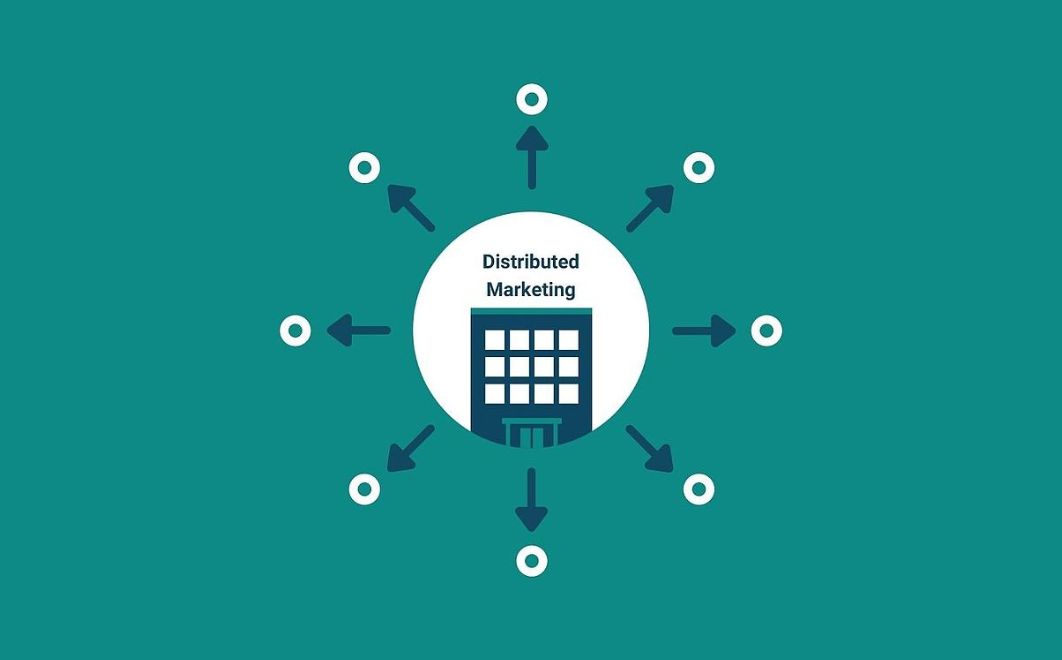What is distributed marketing, what are the trends, what are the benefits and what are the challenges? These questions are answered in this Learning Center article.
What is distributed marketing?
In English, the term “distributed marketing” or “distributed marketing management” is already used very frequently, but sometimes still causes confusion or misunderstandings. Translated, “distributed marketing” means “distributed marketing,” which in German is usually equated with decentralized marketing. This is a “business to business to consumer” chain (B2B2C) in marketing, which is advertised to the end consumer by the head office via individual local sales partners. In most cases, this means that there is a corporate headquarters that not only manages the products, but also provides guidelines for brand identity and general marketing. However, sales are (mostly) decentralized through individual local sales and sales partners. These sales partners are spatially and organizationally separated from each other and each take care of their own area.
Centralized or decentralized organizations?
Whether marketing in a company can be described as distributed marketing depends heavily on the company structure. The higher the degree of centralization, the more decision-making power lies with corporate management and corporate headquarters. They provide guidelines for responsibilities, products and work processes for the entire company. As a result, suggestions and inquiries from partners or local branches are always clarified first via headquarters and only partially implemented. For marketing, it means that the same marketing is carried out at all levels and in all local branches. This is produced centrally and only distributed locally. However, the central decisions mean that the various target groups can be addressed less precisely. This can lead to the central marketing department making more unrealistic decisions, as it has less contact with the end consumer and the needs are sometimes identified more poorly.
A decentralized corporate structure, on the other hand, consists of almost independent business units that are united under one brand. There is central company management and many independent, local business partners (e.g. retailers), each serving their own local target group. The head office plays a coordinating role here and provides guidelines and fundamental decisions. However, the details and respective implementation are at local level. As a result, faster decisions can be made locally, in particular, without necessarily having to ask for approval from the head office. This leads to a greater sense of responsibility and more motivated, independent work among site managers. However, giving too much freedom and ignoring the central guidelines can sometimes lead to problems. In marketing, this would be a classic form of decentralized or distributed marketing. The central marketing department plays a pioneering role here, providing guidelines and representing principles such as corporate identity. Implementation and execution are carried out at a decentralized, local level by the individual sales and sales partners.
Corporate design compliance
In order to skilfully support sales partners in distributed marketing management and still create a uniform brand image, templates (templates) are passed on from headquarters to branches. These templates can be organized into entire campaigns that are relevant and can be used by all sales partners. To allow as many adjustments as possible, these templates are so-called “dynamic content.” This means that not only content such as texts and images (digital assets), but also size and formats can usually be adjusted. This scalability gives distribution partners great freedom in the use of individual marketing materials. In order to require as little coordination as possible and to each sales partner, even without previous knowledge of corporate design and design, only certain parts of the marketing campaign can be individualized. This ensures that all advertising material produced also corresponds to the brand's corporate identity. As a result, as few approval loops as possible are required and distribution partners can be given as much freedom as possible. In order to be able to use these templates as directly as possible, they are usually collected in a cloud and made editable.
What are the benefits of distributed marketing?
- The ability to communicate campaigns and content to all branches at the same time
- Efficiency in the production of marketing materials (saving financial and time resources)
- Improved time-to-market, thanks to fewer approval loops
- Standardization and automation of marketing processes
- Innovative, digital processes in marketing
- Central access point to all templates, information and campaigns
- Controllable freedom and customization options for local sales partners
- Uniform brand management and corporate identity
Challenges in Distributed Marketing Management
The local distribution of individual locations and sales partners poses some challenges in managing distributed marketing. On the one hand, communication between people as well as between sales partners and headquarters is a challenge that must be considered. However, this can be simplified by central software solutions on which marketing campaigns can be accessed. In addition, it must be considered that the templates are used by different people with different skill sets, so the handling should be as simple and self-explanatory as possible. The individual approach partners are also confronted with very different target groups, which each location should address individually. This individuality entails the risk of inconsistency and a neglected general brand image. In addition, it can happen that the individual sales partners place different amounts of value and budget on marketing, which can also result in differences and tensions.
Which current trends are relevant?
There are also trends in distributed marketing management that affect headquarters and sales partners equally and should be addressed:
Digital before print
As in almost every area, there is a clear trend towards digital marketing materials in distributed marketing. Although print is still relevant, it is gradually being replaced by digital alternatives.
Decentralized social media management
Social media are increasingly being tailored to local target groups and are therefore usually managed by local social media management. Social media marketing is therefore an important part of distributed marketing.
Increasing personalization
Thanks to the large amount of user data and advancing artificial intelligence, companies can paint a very accurate picture of their customers. Personalization and individualization for the target group are therefore becoming increasingly important.
Mobile First
Mobile use of the Internet has been widespread in Germany for years. Distributed marketing is also adapting to this development and offers more and more opportunities to bring advertising and mobile content to the target group's smartphone.
New working environments
In a world of remote work and digital workplaces, distributed marketing and coordination offers a good opportunity to communicate with employees and sales partners at various locations and to simplify processes using a software solution.
IT security
An important point in distributed marketing is the processing of data and internal company assets. As a result, the security of the IT systems used is also a very important point when deciding and using the software.
software support
For the best possible implementation of distributed marketing, the use of various software solutions is suitable, which can significantly facilitate everyday work in a decentralized company. Depending on the needs of the brand, different systems can be used.
marketing portals
Marketing portals, on the other hand, are An all-round package that benefits from both web-to-publish and DAM. In addition, an exchange platform with sales partners can be created on which budget and marketing plans as well as brand assets can be shared. By using company-wide templates, ideal distributed marketing can be ensured using a marketing portal.
Digital Asset Management (DAM)
Digital asset management, DAM for short, starts elsewhere. Here is the Exchange of digital assets, i.e. images, graphics, text, music, etc. via a cloud in the foreground. Via a DAM, the head office can provide every sales partner with the same digital assets, which they can use for their own local marketing. It is therefore a shared cloud database to which all marketing operators involved have access.
Web-to-print/Web-to-publish
The simplest and rather smaller solution is to use web-to-print or web-to-publish software. These solutions focus purely on the production and publication of print advertising materials. While a web-to-publish system combines all possible marketing materials and thus makes offline and online marketing possible, a web-to-print solution focuses purely on print. Here, flyers, advertisements, brochures and mailings can be produced and distributed directly to the company's own customers.




